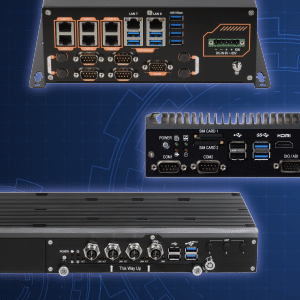AIoT Technology as A Game Changer in Fleet Management

In the era of rapid technological advancement, the convergence of Artificial Intelligence (AI) and the Internet of Things (IoT) has given rise to a revolutionary concept known as AIoT, which stands for AI and IoT combined.
AIoT in fleet management has proven to be a game changer across various industries, and one notable sector reaping its benefits is fleet management. The marriage of AI and IoT in fleet management has unlocked new avenues for more intelligent, efficient, and informed fleet operations.
AIoT is the seamless integration of AI and IoT technologies to create interconnected systems that can perceive, analyze, and act upon data in real time. In fleet management, AIoT is a connected network of vehicles, devices, and sensors that collaborate with AI algorithms to enhance operational efficiency, safety, and decision-making. This dynamic blend enables fleet managers to harness the power of data-driven insights to optimize their operations and redefine the landscape of fleet management.
Fleet management has undergone a paradigm shift with the evolution of AIoT technology. The traditional methods of managing fleets need to be revised to meet the demands of today’s dynamic and fast-paced world. Fleet managers are faced with the challenge of ensuring the efficient movement of vehicles and the safety of passengers, the optimization of routes, and the seamless integration of supply chain operations. This necessitates a solution that provides real-time surveillance, data-driven insights, and predictive analytics to stay ahead in the competitive market.
Why Are IoT Fleet Management Solutions on the Rise?

Safety Concerns
Ensuring safety is a paramount concern in fleet management, especially when it comes to commercial vehicles. AIoT technology offers innovative solutions to monitor driver behavior in real-time.
By equipping vehicles with sensors and cameras, fleet managers can track factors such as speed, braking patterns, and adherence to traffic rules. AI and IoT in fleet management help reduce accidents and allow immediate intervention through alerts or notifications in case of reckless driving.
Moreover, AI IoT in fleet management aids in enhancing passenger safety in various transport modes like buses, taxis, and school buses. The real-time monitoring of these vehicles provides a layer of security for passengers, making their journeys more secure and reliable.
Additionally, the integration of AIoT can play a pivotal role in preventing and addressing violent incidents by alerting authorities in case of any unusual or distressing situations, thereby ensuring the safety of both drivers and passengers.
Efficiency and Route Optimization
Efficiency is essential for successful fleet management. AI IoT in fleet management technology brings forth many tools that contribute to efficient operations, with route optimization being a standout feature. By tracking fleet paths and locations in real time, fleet managers can prevent driver detouring, unauthorized stops, or inefficient routing.
Real-time tracking is especially crucial for commercial fleets as it enables managers to have complete visibility into the movement of their vehicles. This visibility facilitates immediate decision-making, which is essential in the fast-paced logistics industry.
Supply Chain and E-commerce Challenges
The modern supply chain landscape is marked by its complexity and unpredictability. Here, AIoT technology emerges as a savior by addressing challenges such as frequent disruptions and unpredictable order volumes.
With the integration of AI IoT in fleet management, fleet managers can gain insights into supply chain dynamics, anticipate disruptions, and proactively adapt their strategies. This is particularly significant in handling the surge in e-commerce orders, where rapid deliveries are paramount.
AIoT enables fleet managers to optimize real-time routes, ensuring timely deliveries and meeting growing customer expectations for flexible delivery options.
What Is AIoT in Fleet Management?
AIoT, or the Artificial Intelligence of Things, represents a fusion of Artificial Intelligence (AI) with the Internet of Things (IoT). This integration revolutionizes fleets’ operations in fleet management, enhancing efficiency, safety, and decision-making.
Technological Components
The core of AIoT in fleet management lies in integrating various cutting-edge technologies. High-definition (HD) cameras monitor the vehicles’ internal and external environment.
Intelligent sensors are embedded within the vehicles to detect and respond to real-time changes, such as sudden braking or changes in temperature. AI-integrated software analyzes the data collected, enabling fleet managers to make informed decisions. Communication and display systems ensure that the information is readily available to drivers and managers.
The synergy of these components allows for a holistic view of the entire fleet operation. For example, integrating HD cameras with AI algorithms can detect unsafe driving behaviors, such as drowsiness or distraction, and alert the driver or fleet manager.
Evolution and Learning
The ability to learn and evolve sets AIoT fleet management systems apart from traditional methods, and as these systems are fed more data, they become more intelligent and accurate. Machine learning algorithms analyze historical and real-time data to identify patterns, predict potential issues, and recommend solutions.
This continuous learning process enables the system to adapt to new challenges and scenarios. For instance, if a particular route consistently experiences delays due to traffic, the system can learn from this pattern and suggest alternative ways in the future.
Key Benefits of AI IoT Fleet in Management Systems
Life Support and Safety
Video Recording through Telematics AIoT fleet management systems integrates telematics and video recording capabilities to enhance life support and safety measures. By equipping vehicles with cameras and sensors, these systems enable real-time video monitoring of both the vehicle’s exterior and interior.
These recordings are crucial evidence for assessing fault and liability in accidents or incidents. Moreover, continuous video surveillance can deter risky behaviors and ensure compliance with safety protocols.
For monitoring vehicles for Faults and Proactive Maintenance Updates, AIoT-enabled sensors monitor vehicle components and systems for anomalies and faults. These systems can detect irregularities in engine performance, transmission, brakes, and other critical parts.
The real-time data collected allows fleet managers to receive proactive maintenance alerts and updates. This proactive approach minimizes the chances of unexpected breakdowns, reduces maintenance costs, and keeps vehicles operating at optimal efficiency.
Efficiency and Performance
- Minimizing Unexpected Vehicle Downtime
AIoT fleet management systems contribute significantly to operational efficiency by minimizing unexpected vehicle downtime. Through continuous monitoring of vehicle health and performance, these systems can predict potential issues before they escalate into major problems.
- Providing Drivers with Real-time Feedback
Real-time feedback mechanisms integrated into AIoT systems provide drivers valuable insights into their driving behavior. These systems collect data on driving habits such as acceleration, braking, and speed.
Drivers receive immediate notifications and feedback regarding their performance, allowing them to make instant adjustments. This promotes safer driving practices, enhances fuel efficiency, and reduces vehicle wear and tear.
- Assessing Driver Performance and Identifying Training Needs
AI IoT in fleet management systems analyzes driver behavior over time to assess overall performance. By tracking metrics like adherence to traffic rules, compliance with speed limits, and fuel-efficient driving, fleet managers can identify drivers who consistently excel and those who may need additional training.
Activating IoT in Future Fleet Management
In the rapidly evolving landscape of commercial transportation, prioritizing driver safety has become paramount. However, this emphasis on safety must not come at the expense of cost or efficiency. This is where the integration of IoT in future fleet management becomes essential.
Commercial transportation systems face complex challenges, from fluctuating fuel prices to increasing regulatory compliance. Traditional methods of fleet management are needed to meet these demands. Activating IoT technology offers a solution that balances safety with efficiency and cost-effectiveness.
IoT-enabled fleet management systems monitor vehicle performance, driver behavior, and environmental conditions. This data-driven approach allows for proactive measures, reducing accidents and minimizing downtime. It also enables more precise route planning and fuel consumption monitoring, leading to significant cost savings.
As we look toward the future of fleet management, integrating IoT is not just an option; it’s a necessity. It’s time to embrace this technology and transform how fleets are managed.
At SINTRONE, we are at the forefront of this technological revolution. We invite you to explore our innovative fleet management solutions, designed to meet the unique challenges of today’s commercial transportation industry.
With SINTRONE, you can ensure safety, efficiency, and cost-effectiveness, positioning your fleet for success in the future. Visit our website to discover how we can help you take the next step in fleet management innovation.




